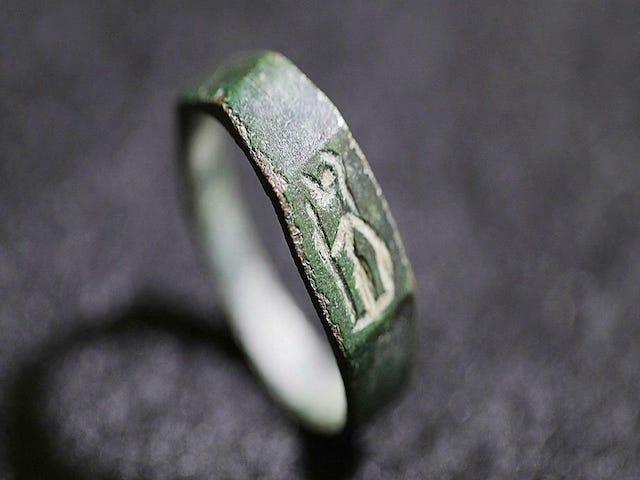In a stroke of serendipity, 13-year-old Yair Whiteson from Haifa has stumbled upon an archaeological gem while hiking on Mount Carmel in northern Israel. This isn't just any discovery; it's an ancient engraved ring bearing the image of Athena, the revered Greek goddess of war. The Israel Antiquities Authority (IAA) has confirmed this incredible find, which will soon take pride of place in a Jerusalem exhibit.
This July, visitors to the Jay and Jeanie Schottenstein National Campus for the Archaeology of Israel in Jerusalem will have the rare opportunity to gaze upon Whiteson's remarkable find. The ring, a relic of the Late Roman Period, dates back to the 2nd-3rd Century CE and provides a tangible connection to the rich tapestry of history that unfolded in the Land of Israel.
The Unlikely Explorer
Yair's passion for fossils and rocks proved instrumental in this extraordinary discovery. While hiking near the ancient quarry site below Khirbet Shalala with his father, recently returned from a four-month army reserve duty stint, Yair's keen eye caught sight of a small green object. Initially dismissed as a rusty bolt, closer inspection revealed it to be a corroded ring with an intricate engraving.
👦 During a hike on Mount Carmel, 13-year-old Yair Whiteson from Haifa stumbled upon an 1800-year-old bronze ring engraved with the image of Athena.
— Israel Daily News Podcast (@IsraelPodcast) July 17, 2024
💍 This remarkable find occurred near the ancient quarry site below Khirbet Shalala. Yair, an avid collector of #fossils and
1/4 pic.twitter.com/vv9dMqU4Oa
“At first glance, I thought it was a warrior,” Yair recounted, highlighting his initial excitement and curiosity.
Recognizing the potential significance of the find, the family promptly contacted Nir Distelfeld, an inspector at the IAA’s Theft Prevention Unit. Swift action ensued, and the ring was transferred to the National Treasures Department, where Prof. Shua Amorai-Stark, an authority on ancient rings and amulets from the Kaye Academic College, was consulted.
Deciphering the Ancient Artifact
The ring, now confirmed to be a beautifully preserved artifact, depicts a helmeted, naked figure wielding a shield in one hand and a spear in the other. Distelfeld and Dr. Eitan Klein of the IAA's Unit for the Prevention of Antiquities Robbery explained that Yair's identification was impressively close. The figure is likely Minerva from Roman mythology, synonymous with Athena in Greek lore. During the Roman period in the Land of Israel, Athena was venerated as the goddess of war, military strategy, and wisdom.
3,000 years old & 76 years young, Israel is a treasure trove. Yair Whiteson, 13, discovered this 1,800-year-old bronze ring of Athena on Mount Carmel. This Roman-era find now joins the Israel Antiquities Authority's collection.@IsraelAntiquity pic.twitter.com/QwlAqWkO2r
— Israel in the UK 🇮🇱🤝🇬🇧 (@IsraelinUK) July 19, 2024
A Glimpse into the Past
The bronze ring, believed to have belonged to a female—perhaps a resident of a farmstead, a quarry worker, or even a burial offering in a nearby cave—provides a fascinating glimpse into the daily lives and spiritual beliefs of those who lived centuries ago.
Khirbet Shalala, the nearby archaeological site, sits atop a hill in the Carmel Mountains, flanked by Nahal Oren and the perennial water source Ein Alon. This site has long captivated archaeologists, including the renowned 19th-century Palestine Exploration Fund surveyor Prof. Ruth Miran and a Bar-Ilan University expedition led by Prof. Shimon Dar.
Yair Whiteson, 13, who has been looking for gemstones and fossils since he was 5 years old finds ancient ring engraved with 'goddess of war' while on a walk with his dad. #Israel #Archaeology #Treasures #Artifacts #History https://t.co/ypmKR1LhcT via @ArutzSheva_En
— ImaZionist (@ImaZionist) July 17, 2024
From Discovery to Display
Yair Whiteson's find is set to captivate visitors to the Jay and Jeanie Schottenstein National Campus for the Archaeology of Israel, where it will be displayed alongside other treasures that tell the story of Israel's rich and diverse history. The IAA is offering tours throughout the summer, allowing history enthusiasts to immerse themselves in the ancient past.
This tale of youthful curiosity leading to a significant archaeological discovery is a testament to the enduring allure of history and the unexpected ways in which it can resurface. Yair Whiteson’s keen observation and quick action have brought an ancient goddess back into the light, offering a new chapter in the storied history of the Land of Israel.


